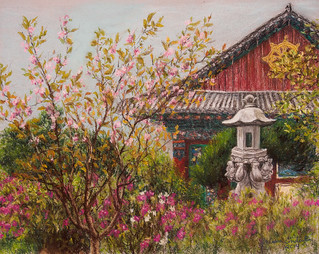Fall is not just about leaves in Korea. Another colorful symbol of fall is the chrysanthemum flower. The Jogyesa Buddhist Temple in Seoul holds an annual festival in October featuring this Korean autumn flower. Even some trees get decked out with mums.
The "flower tree" in the background cascades with clusters of yellow and burgandy mums, but it also looks a bit spider-like. Just as in the temple's lantern festival, tags stick out of the displays, recognizing contributors. It is also a testament to the labor of love for those involved with the festival.
When I traveled to the Andong region, I saw fields of chrysanthemums being harvested. Many will adorn temples and parks within the country. Chrysanthemums are also dried and used to make tea.








































